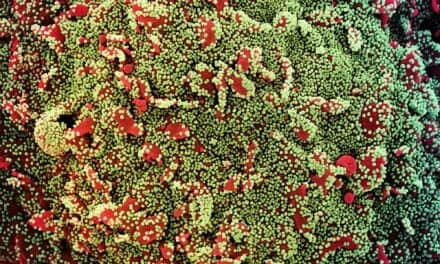Newly published research reinforces the existing clinical and economic evidence supporting the efficacy, safety profile, continued use, and cost-effectiveness of Acthar Gel, according to a news release from Mallinckrodt plc.
Acthar is a naturally sourced complex mixture of adrenocorticotropic hormone analogs and other pituitary peptides. Acthar Gel is an FDA-approved therapy for the treatment of a number of autoimmune and inflammatory diseases, including symptomatic sarcoidosis. Sarcoidosis can impact any organ, but it most often impacts the lungs, with nearly 90% of patient suffering lung problems, according to data cited by Mallinckrodt.
Clinical Evidence
Mallinckrodt’s clinical manuscript titled “Acthar Gel Treatment for Patients with Autoimmune and Inflammatory Diseases: A Historical Perspective and Characterization of Clinical Evidence” was published on October 4, 2023 in the journal, Clinical Drug Investigation.
Authored by Jeffrey Kaplan, MD, Kansas City Multiple Sclerosis & Headache Center, and colleagues, the articles sought to review the history of Acthar and the findings of existing literature on preclinical and clinical studies that have investigated the mechanism of action, safety profile, efficacy, and real-world effectiveness of Acthar. The indications addressed in the study include the treatment of inflammatory diseases such as rheumatoid arthritis (RA), systemic lupus erythematosus (SLE), dermatomyositis and polymyositis (DM/PM), multiple sclerosis (MS) relapse, inflammatory ocular diseases, sarcoidosis, and nephrotic syndrome (NS).1
- As a result of this analysis spanning more than 20 preclinical mechanistic studies and 15 clinical studies with a combined enrollment of approximately 900 patients, and the publication of over 500 manuscripts and abstracts to date, the findings reinforce the safety profile, efficacy, and usage of Acthar in appropriate patients with inflammatory diseases for whom standard treatments may have become ineffective or associated with intolerable side effects.1
“Acthar Gel has an established efficacy and safety profile supported by robust clinical research and experience,” said Dr. Kaplan. “For patients and providers managing the challenges associated with chronic inflammatory and autoimmune conditions, the findings of this study further elucidate Acthar’s proposed mechanism of action and reinforce the extensive history of clinical evidence that has shown its potential to improve health and treatment outcomes across a range of FDA-approved indications.”
Economic Evidence
Mallinckrodt’s health economics manuscript titled “Acthar Gel (RCI): A Narrative Literature Review of Clinical and Economic Evidence” was published on June 24, 2023 in ClinicoEconomics and Outcomes Research.
Authored by George J. Wan, PhD, MPH, vice president, Evidence Generation and Data Sciences at Mallinckrodt, and colleagues, the research reviewed key studies of clinical efficacy and healthcare resource utilization and cost from 1956 to 2022 to summarize the key clinical and economic findings among nine FDA-approved Acthar Gel indications: infantile spasms (IS), MS relapse, RA, SLE, DM/PM, ocular inflammatory diseases (primary uveitis and severe keratitis), symptomatic sarcoidosis, and proteinuria in NS.
- This analysis found that among all nine medical conditions studied, Acthar has shown effectiveness in reducing symptoms, improving functioning and well-being, reducing disease relapse, and/or increasing disease remission.2
- Economic data from this analysis suggests that Acthar is a cost-effective, value-based treatment option for MS relapse, RA, and SLE. Other economic benefits have been demonstrated for IS, MS relapses, RA, SLE, and DM/PM, including reduced hospitalizations, length of stay, inpatient and outpatient services, and emergency department visits.2
“The findings of this health-economics analysis deepen our understanding of Acthar’s ability to serve as a cost-effective, value-based treatment option across multiple FDA-approved indications studied – including how appropriate use of Acthar may be associated with reduction of healthcare utilization costs such as total hospitalizations, patient length of stay, and concurrent treatment burden, such as the use of corticosteroids,”2 said Wan.
References
1 Data on File. Ref-06841. Mallinckrodt Pharmaceuticals.
2 Wan GJ., Niewoehner J., Hayes K. Acthar Gel (RCI): A Narrative Literature Review of Clinical and Economic Evidence. ClinicoEconomics and Outcomes Research. 2023; 15:499-512. https://doi.org/10.2147/CEOR.S410082
3 Acthar® Gel (repository corticotropin injection) [prescribing information]. Mallinckrodt ARD LLC.
4 Types of Myositis. The Myositis Association. Available at: http://www.myositis.org./learn-about-myositis/types-of-myositis. Accessed August 2023.
5 Medline Plus. Myositis. Available at: https://medlineplus.gov/myositis.html. Accessed August 2023.
6 Mayo Clinic. Polymyositis. Available at: http://www.mayoclinic.org/diseases-conditions/polymyositis/basics/symptoms/con-20020710. Accessed August 2023.
7 Rheumatology Center. About Dermatomyositis and Polymyositis. Available at: https://www.actharrheumatology.com/dermatomyositis-and-polymyositis/about-dermatomyositis-and-polymyositis. Accessed August 2023.
8 Bernatsky S, et al. Estimating the prevalence of polymyositis and dermatomyositis from administrative data: age, sex and regional differences. Ann Rheum Dis. 2008;68:1192-1196.
9 Wheless J, Gibson P, Rosbeck K, et al. Infantile spasms (West syndrome): update and resources for pediatricians and providers to share with parents. BMC Pediatrics. 2012;12(1):108. doi:10.1186/1471-2431-12-108.
10 Go CY, Mackay MT, Weiss SK, et al. Evidence-based guideline update: medical treatment of infantile spasms. Neurology. 2012; 78:1974-1980.
11 Multiple Sclerosis Foundation. Get Educated-Common Questions-Multiple Sclerosis. Available at: https://www.acthar.com/Static/pdf/IS_Caregiver_Brochure_English.pdf. Accessed August 2023.
12 National Multiple Sclerosis Society. Relapsing-remitting MS (RRMS). Available at: http://www.nationalmssociety.org/What-is-MS/Types-of-MS/Relapsing-remitting-MS. Accessed August 2023.
13 National Multiple Sclerosis Society. MS Symptoms & Signs of MS. Available at: https://www.nationalmssociety.org/Symptoms-Diagnosis/MS-Symptoms. Accessed September 2023.
14 National Institute of Health. National Institute of Diabetes and Digestive Kidney Diseases. Nephrotic Syndrome in Adults. 2020. Available at: https://www.niddk.nih.gov/health-information/kidney-disease/nephrotic-syndrome-adults. Accessed September 2023.
15 NephCure Kidney International. Nephrotic Syndrome. Available at https://nephcure.org/livingwithkidneydisease/understanding-golmerular-disease/understanding-nephrotic-syndrome/. Accessed September 2023
16 NephCure Kidney International. Focal Segmentation Glomerulosclerosis. Available at https://nephcure.app.box.com/s/rc98yosh958s00ea0g44d1pul8iesz9a/. Accessed September 2023.
17 NIDDK. IgA Nephropathy. Available at: https://www.niddk.nih.gov/health-information/kidney-disease/iga-nephropathy/. Accessed September 2023.
18 Satpathy HK. IgA Nephropathy. In: Ferri FF, ed. Ferri’s Clinical Advisor 2013. 1st ed. St Louis: Mosby; 2012; 570-571.
19 Troyanov et al. J Am Soc Nephrol. 2005;16(4):1061–1068.
20 What is Rheumatoid Arthritis? Arthritis Foundation. Available at: http://www.arthritis.org/about-arthritis/types/rheumatoid-arthritis/what-is-rheumatoid-arthritis.php. Accessed August 2023.
21 Lupus Detailed Fact Sheet. 2018. The Centers for Disease Control and Prevention. Available at: https://www.cdc.gov/lupus/facts/detailed.html#previnc. Accessed September 2023.
22 Lupus Foundation of America. National Resource Center on Lupus. Lupus Fact and Statistics. 2018. Available at: https://resources.lupus.org/entry/facts-and-statistics. Accessed September 2023.
23 Sarcoidosis. American College of Chest Physicians. Available at: http://chestnet.org/sarcoid. Accessed September 2023.
24 Sarcoidosis Overview. 2019. Cleveland Clinic. Available at: https://my.clevelandclinic.org/health/diseaes/11863-sarcoidosis-overview. Accessed September 2023.
25 Judson MA, Boan AD, Lackland DT. The Clinical Course of Sarcoidosis: Presentation, Diagnosis, and Treatment in a Large White and Black Cohort in the United States. Sarcoidosis Vasc Diffuse Lung Dis. 2012. 29(2);119-127.
26 Chopra I, et al. Repository Corticotropin Injection in Patients with Advanced Symptomatic Sarcoidosis: Retrospective Analysis of Medical Records. Ther Adv Res Dis. 2019(13);1-11. DOI: 10.1177/1753466619888127.
27 Barisani-Asenbauer T, Maca SM, Mejdoubi L, Emminger W, Machold K, Auer H. Uveitis—a rare disease often associated with systemic diseases and infections—a systematic review of 2619 patients. Orphanet J Rare Dis. 2012;7:57.
28 Mustafa M, Muthusamy P, Hussain SS, Shimmi SC, Sein MM. Uveitis: pathogenesis, clinical presentations and treatment. IOSR J Pharm. 2014;4:42-47.
29 Guly CM, Forrester JV. Investigation and management of uveitis. BMJ. 2010;341:c4976.
30 Chan CC, Li Q. Immunopathology of uveitis. Br J Ophthalmol. 1998;82:91-99.
31 Lee RWJ, Dick AD. Current concepts and future directions in the pathogenesis and treatment of non-infectious intraocular inflammation. Eye. 2012;26(1):17-28. doi:10.1038/eye.2011.255.
32 Acharya, NR, Tham VM, Esterberg E, et al. Incidence and prevalence of uveitis: results from the Pacific Ocular Inflammation Study. JAMA Ophthalmol. 2013;131:1405-1412.
33 Gritz DC, Wong IG. Incidence and prevalence of uveitis in Northern California; the Northern California Epidemiology of Uveitis Study. Ophthalmology. 2004;111:491-500; discussion 500.
34 Suhler EB, Lloyd MJ, Choi D, Rosenbaum JT, Austin DF Incidence and prevalence of uveitis in Veterans Affairs Medical Centers of the Pacific Northwest. Am. J. Ophthalmol. 2008;146:890.e8–896.e8
35 Sharma S. Keratitis. Bioscience Reports. 2001;21:419-444.
36 Collier SA, Gronostaj MP, MacGurn, AK, Cope JR, Awsumb KL, Yoder JS, et al. Estimated burden of keratitis–United States, 2010. MMWR Morb Mortal Wkly Rep. 2014;63(45):1027–1030.
37 Donzis PB, Mondino BJ. Management of noninfectious corneal ulcers. Surv Ophthalmol. 1987;32:94–110.










